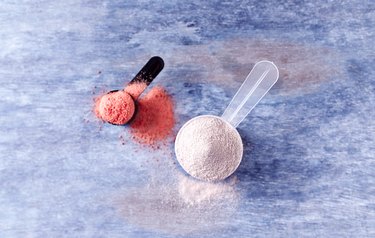
If you're familiar with dietary supplements, then you're probably familiar with whey protein. But, with so many different products on the market, it might be difficult to sort them out. Wheybolic is a brand name protein powder that's made with whey protein isolate, and higher in protein content.
Dietary proteins are found in eggs, milk and animal meats. These foods contain all the essential amino acids needed by the body for tissue growth and repair, making them "complete" proteins.
Video of the Day
Video of the Day
Vegetarian sources of protein as also available, but they are considered "incomplete," as they do not contain all the amino acids. Whey protein is a complete protein.
Read more: Is Whey Protein Good or Bad?
Whey vs. Whey Protein Isolate
Whey is one of the two proteins found in milk. When whey is separated from the other components of milk, some of the fat and carbohydrate remain.
The whey powder undergoes a filtration process that helps concentrate the protein to limit the amount of fat and carbs in the product, creating the whey protein concentrate.
Whey protein isolate is processed even further to filter out most of the fat and carbs to create an almost pure protein product. According to a February 2014 article published by International Journal of Current Research and Review, whey protein isolate is more easily digested as well.
Consider the Protein Content
According to the USDA, a 30-gram scoop of whey protein powder with whey protein concentrate contains 22 grams of protein. The same serving of whey protein isolate contains 20 grams of protein.
According to the National Academies of Sciences, adult males need 56 grams of protein per day, while women need 46 grams. The recommended serving for Wheybolic is 2 scoops or 62.5 grams, which translates to 40 grams of protein.
Count Calories, Carbs and Fat
Wheybolic is lower in carbohydrates and fat, as well as calories, than a whey protein powder. A 2-scoop serving of Wheybolic has 200 calories, 6 grams of carbohydrates and 1.5 grams of fat, versus 240 calories, 8 grams of carbohydrates and 4 grams of fat in 2 scoops of whey protein powder.
Wheybolic can be taken before or after workouts, between meals or even on rest days, according to its label. In addition to protein, however, your post-workout meal should include carbohydrates and fat to promote repletion of energy stores while sparing the protein for muscle repair and growth.
Read more: Gold Standard Whey Protein Side Effects
Don't Forget the Other Macros
If you're taking the protein powder as suggested, after your workout, you'll need to mix the powder with a source of carbohydrates and fat to get the most benefit, as recommended by the American College of Sports Medicine.
For example, you can blend your scoop of Wheybolic with a banana, almond milk, almond butter and ice to get a mix of all the necessary nutrients.
You may be able to simply mix a whey protein powder in a glass of low-fat milk or a plant-milk alternative to get the nutrients you need and provide a slightly better source of carbohydrates and fat.
- GNC.com: "GNC AMP Wheybolic"
- USDA FoodData Central: "Whey Protein Powder"
- American College of Sports Medicine: "Industry Presented Blog: What to Eat Before and After a Workout"
- National Academies of Sciences: "Macronutrients"
- International Journal of Current Research and Review: "Protein Isolates: Production, Functional Properties and Application"